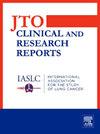Early Weight Gain as a Risk Factor for Increased Maximum Weight Gain Among Patients With NSCLC on Lorlatinib and Other ALK Tyrosine Kinase Inhibitors
IF 3.5
Q2 ONCOLOGY
引用次数: 0
Abstract
Introduction
Therapy-associated weight gain affects the quality of life and health of patients with ALK-positive NSCLC treated with tyrosine kinase inhibitors (TKIs). The severity and timing of real-world weight gain on ALK TKIs and associated risk factors are poorly understood, impairing timely interventions.
Methods
A retrospective chart review of patients with ALK-positive NSCLC receiving TKIs at our institution from January 1, 2020 to December 31, 2023 was conducted. Demographics, metabolic comorbidities, treatment details, and clinic-measured weights were collected. The grade of weight gain, maximum weight gain (% of baseline), and early weight gain (within 6 mo of TKI start) were calculated. Univariable and multivariable linear mixed effects analyses for predictors of weight gain were performed.
Results
A total of 91 patients received 156 treatment lines of TKI. Patients receiving lorlatinib experienced significantly higher maximum weight gain (mean 13.5% [95% confidence interval 10.8–16.2]) than those receiving other TKIs (p <0.001). Any-grade and grade 3 weight gain rates exceeded those from clinical trials. In multivariate modeling, early weight gain of at least 5% within 6 months (p <0.001), lorlatinib use (p = 0.007), and age 50 years or younger (p = 0.046) were associated with maximum weight gain. Among patients receiving lorlatinib, early weight gain (p = 0.001) remained significantly associated with higher maximum weight gain.
Conclusions
In this real-world cohort, rates and severity of weight gain on ALK TKIs were higher than in registrational trials, and highest on lorlatinib. Patients with early weight gain of greater than or equal to 5% within 6 months developed higher maximum gain. Prospective investigation of early weight management interventions is encouraged.
Lorlatinib和其他ALK酪氨酸激酶抑制剂治疗的NSCLC患者早期体重增加是最大体重增加的危险因素
治疗相关体重增加影响alk阳性NSCLC患者使用酪氨酸激酶抑制剂(TKIs)治疗的生活质量和健康。ALK tki患者体重增加的严重程度和时间以及相关风险因素尚不清楚,从而影响了及时干预。方法回顾性分析我院2020年1月1日至2023年12月31日接受tki治疗的alk阳性NSCLC患者的病历。收集了人口统计学、代谢合并症、治疗细节和临床测量的体重。计算体重增加的等级、最大体重增加(基线的百分比)和早期体重增加(TKI开始后6个月内)。对体重增加的预测因子进行单变量和多变量线性混合效应分析。结果91例患者共接受TKI 156个治疗线。与接受其他TKIs的患者相比,接受lorlatinib的患者最大体重增加(平均13.5%[95%可信区间10.8-16.2])显著更高(p <0.001)。任何级和3级的体重增加率都超过了临床试验的结果。在多变量模型中,6个月内早期体重增加至少5% (p <0.001)、使用氯拉替尼(p = 0.007)和年龄在50岁或以下(p = 0.046)与最大体重增加有关。在接受氯拉替尼治疗的患者中,早期体重增加(p = 0.001)仍然与最大体重增加显著相关。结论:在这个真实世界的队列中,ALK TKIs的体重增加率和严重程度高于注册试验,且氯拉替尼组体重增加率最高。6个月内早期体重增加大于或等于5%的患者出现更高的最大增重。鼓励对早期体重管理干预进行前瞻性研究。
本文章由计算机程序翻译,如有差异,请以英文原文为准。
求助全文
约1分钟内获得全文
求助全文
来源期刊

JTO Clinical and Research Reports
Medicine-Oncology
CiteScore
4.20
自引率
0.00%
发文量
145
审稿时长
19 weeks
 求助内容:
求助内容: 应助结果提醒方式:
应助结果提醒方式:


